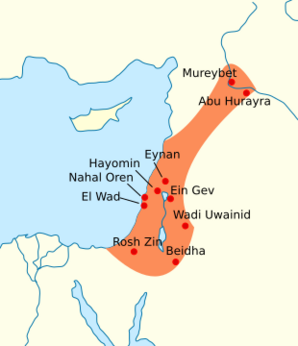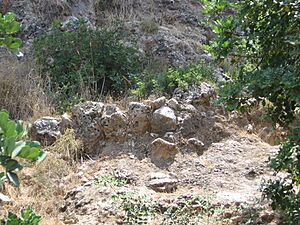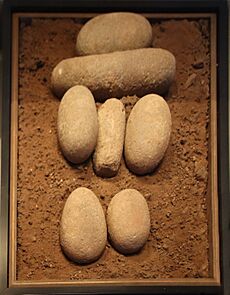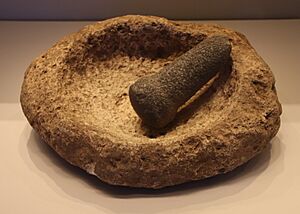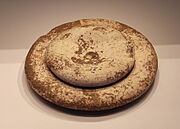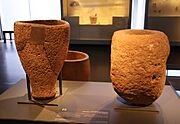Natufian culture facts for kids
|
A map of the Levant with Natufian regions across present-day Israel, Palestine, Jordan, and a long arm extending into Lebanon and Syria
|
|
| Geographical range | Levant, Western Asia |
|---|---|
| Period | Epipaleolithic |
| Dates | 15,000–11,500 BP |
| Type site | Shuqba cave, in Wadi Natuf |
| Major sites | Shuqba cave, Ain Mallaha, Ein Gev, Tell Abu Hureyra |
| Preceded by | Kebaran, Mushabian |
| Followed by | Neolithic: Khiamian, Shepherd Neolithic |
The Natufian culture was an ancient way of life in the Levant region of Western Asia. This period, called the Epipaleolithic, happened about 15,000 to 11,500 years ago. What made the Natufians special was that they lived in one place, or mostly in one place, even before farming began.
These Natufian groups might have been the ancestors of the people who built the very first farming villages. Some clues suggest they even grew their own plants, like rye, at a place called Tell Abu Hureyra. This could be the earliest sign of farming in the world. Also, the oldest known bread-like food was found at Shubayqa 1 in Jordan. It's about 14,400 years old, much older than when farming really took off.
Scientists also found signs of very old beer-making at Raqefet Cave. This was about 13,000 years ago. But it's possible the beer was made by accident. Mostly, Natufians gathered wild grains and hunted animals, especially gazelles. Studies of their genes show that later people in the Levant came mostly from the Natufians.
The name "Natufian" was created by an archaeologist named Dorothy Garrod. She found their tools and remains during her digs at Shuqba cave.
Contents
Discovering the Natufian Culture
The Natufian culture was found by a British archaeologist, Dorothy Garrod. She was digging at Shuqba cave in the Judean Hills in 1928. Before the 1930s, most archaeology in the area focused on Bible times. Not much was known about earlier periods.
In 1928, Garrod was asked to dig at Shuqba cave. Stone tools had been found there a few years before. She discovered a layer of earth with tiny stone tools called microliths. This layer was between older Stone Age tools and newer Bronze Age items. She realized this was a "Mesolithic" period. This time was well known in Europe but not yet found in the Middle East.
A year later, she found similar tools at another site. Garrod then suggested the name "the Natufian culture." She named it after Wadi an-Natuf, a valley near Shuqba cave. Over the next 20 years, Garrod and other archaeologists found more Natufian sites. This helped to firmly place the Natufian culture in the history of the region. As early as 1931, Garrod noticed stone sickles at Natufian sites. This made her think that early farming might have been happening.
When the Natufian Culture Existed

Scientists use Radiocarbon dating to figure out how old things are. They found that the Natufian culture existed from about 12,500 to 9,500 BC. This was at the very end of the Pleistocene Ice Age and the start of the Holocene period.
This time is usually split into two parts. The Early Natufian was from 12,000 to 10,800 BC. The Late Natufian was from 10,800 to 9,500 BC. The Late Natufian period happened during a cold, dry time called the Younger Dryas. The Levant region had many types of wild grains, fruits, and nuts back then. The land was not dry and barren like today. It was covered in woodland.
Cultures Before and Around the Natufians
The Natufian culture grew in the same area as the earlier Kebaran culture. Many think the Natufians developed from the Kebaran people. There were also other groups nearby, like the Mushabian culture in the Negev desert. Some believe these groups also played a part in how the Natufian culture began.
Scientists have also looked at how these cultures are similar to those in North Africa. For example, some Natufians, like the Iberomaurusian and Capsian cultures, sometimes removed their upper front teeth.
Some experts, like Ofer Bar-Yosef, thought that ideas came from North Africa to the Levant. But newer research shows that many of the tool-making skills were already present in the Eastern Levant. So, the Natufians didn't necessarily get all their ideas from elsewhere.
One idea is that people in North Africa started using plants a lot. This might have led to farming in the Fertile Crescent. But this is just a guess, as more proof is needed from North Africa. In fact, the earliest known intense use of plants was in the Levant, 23,000 years ago. This was at the Ohalo II site.
Some studies of ancient bones suggest that Natufians were a mix of people. They had links to ancient Europeans and also to a group from the Arab peninsula. This mix helped form the Natufian population.
Natufian Settlements
Most Natufian settlements are found in Israel and Palestine. This might be because these areas have been studied more by archaeologists. But sites have also been found in Syria, Lebanon, Jordan, and the Sinai Desert. Natufian settlements were larger and more permanent than those before them.
Some Natufian sites had buildings made of stone. Ain Mallaha is an example, with round stone structures. Cave sites were also common. El Wad is a cave site where people lived at the front, on a terrace. Some Natufian groups lived in forests, while others lived near mountains.
The Natufians were likely the first to store food. Not all sites have storage areas, but some do. It's also thought that Natufians visited Cyprus. This means they traveled long distances over water.
Natufian Tools and Art
Stone Tools
The Natufians made small stone tools called microliths. These were often short blades and bladelets. They used a special way to shape the stones. Their tools included tiny crescent shapes, trapezoids, and triangles.
A special way of sharpening tools, called Helwan retouch, was common in the early Natufian period. Later, a type of arrowhead called the Harif-point became popular in the Negev. Some experts think this point defines a separate culture, the Harifian.
Sickle blades also appeared for the first time with the Natufians. These tools have a shiny polish from cutting plants. This suggests they were used to harvest wild grains. This is an early sign of farming. They also used stone tools to straighten arrow shafts, showing they practiced archery. Heavy stone bowls and mortars were also used.
Burials
Natufian graves often contained special items. These included shells, animal teeth, bones, and stones. They made pendants, bracelets, necklaces, earrings, and belt decorations.
In 2008, a very important Natufian woman's grave was found in a cave in northern Israel. She was buried in a special pit. News reports called her a "shaman." Her burial included bones from three large wild cattle and 86 tortoises. These animals were likely eaten at her funeral feast. Her body was surrounded by tortoise shells, a leopard pelvis, a boar forearm, a golden eagle wingtip, and a beech marten skull.
Trading Over Long Distances
At Ain Mallaha, archaeologists found black volcanic glass called obsidian from Anatolia (modern Turkey). They also found seashells from the Nile valley in Egypt. This shows that the Natufians traded with people far away. The source of their green malachite beads is still a mystery. Natufians also brought figs from Africa to the Fertile Crescent around 10,000 BC.
Other Discoveries
The Natufians were skilled at working with bone. They made harpoons and fish hooks. They also crafted pendants and other decorations from stone and bone. A few human figures made of limestone have been found. But they seemed to prefer making art of animals. Containers made from ostrich eggshells were found in the Negev.
In 2018, the world's oldest brewery was found in a cave near Haifa, Israel. It had traces of 13,000-year-old beer. This means beer was made 8,000 years earlier than previously thought!
A study from 2019 showed that Natufians knew how to make high-quality plaster. They used it at a cemetery site called Nahal Ein Gev II. This was 12,000 years ago. This kind of plaster was thought to have been made 2,000 years later.
How Natufians Lived
The Natufian people got their food by hunting and gathering. It's hard to find old plant remains because of the soil. But at some sites, like Tell Abu Hureyra, many plant remains were found. They collected wild grains, beans, almonds, acorns, and pistachios.
Animal bones show that they mainly hunted mountain and goitered gazelles. They also hunted deer, wild cattle, and wild pigs in the open areas. In the Jordan River valley, they ate waterfowl and freshwater fish. Some animal bones suggest they hunted together using nets.
The Start of Farming
A bread-like food, similar to pita, was found from 12,500 BC. It was made by Natufians from wild cereal seeds and plant roots ground into flour.
One idea is that a sudden climate change, the Younger Dryas event, led to farming. This event caused a drought in the Levant. The wild grains they relied on were in danger. To survive, people started clearing land and planting seeds. This is how they began farming. However, this idea about farming's origin is still debated by scientists.
Domesticated Dogs
At the Natufian site of Ain Mallaha, scientists found the remains of an old human and a four-to-five-month-old puppy buried together. This was about 12,000 BC. At another site, Hayonim Cave, humans were found buried with two dog-like animals. This suggests that Natufians were among the first people to have dogs as pets or helpers.
Natufian Ancestry
Studies of ancient DNA show that the Natufian people formed from a mix of groups. One group was like early Europeans. The other group was from the local Arabian area.
Scientists have also found genetic links between Natufians and older groups in North Africa. This suggests that people moved and mixed between these regions a long time ago. Later populations in the Middle East became less genetically diverse due to mixing with Natufians and other groups.
There is also evidence that people from the Near East moved into Africa. This might be linked to the spread of Afroasiatic languages. Some studies suggest that Natufians are genetically similar to modern people from the Arabian Peninsula, like Saudi Arabians and Yemenis. These modern groups get most of their genes from local hunter-gatherers like the Natufians.
Natufian Language
Some experts believe the Natufian culture is linked to the very first proto-Afroasiatic language. They think this language started in the Levant. Other experts believe the Afroasiatic language family began in North Africa or Northeast Africa. This could be in Egypt, the Sahara, the Horn of Africa, or Sudan. Within this group, some think that Afroasiatic languages already existed during the Natufian period. They would link the Natufians only to the early Proto-Semitic branch of Afroasiatic.
Natufian Sites
Archaeologists have found and studied about 90 Natufian sites. Some of these include:
- Aammiq 2
- Tell Abu Hureyra
- Abu Salem
- Abu Usba
- Ain Choaab
- Ain Mallaha (Eynan)
- Ain Rahub
- Ain Sakhri
- Ala Safat
- Antelias Cave
- Azraq 18 (Ain Saratan)
- Baaz
- Bawwab al Ghazal
- Beidha
- Dederiyeh
- Dibsi Faraj
- El Khiam
- El Kowm I
- El Wad
- Erq el Ahmar
- Fazael IV & VI
- Gilgal II
- Givat Hayil I
- Har Harif K7
- Hatoula
- Hayonim Cave and Hayonim Terrace
- Hilazon Tachtit
- Hof Shahaf
- Huzuq Musa
- Iraq ed Dubb
- Iraq el Barud
- Iraq ez Zigan
- J202
- J203
- J406a
- J614
- Jayroud 1–3 & 9
- Jebel Saaidé II
- Jeftelik
- Jericho
- Kaus Kozah
- Kebara
- Kefar Vitkin 3
- Khallat Anaza (BDS 1407)
- Khirbat Janba
- Kosak Shamali
- Maaleh Ramon East
- Maaleh Ramon West
- Moghr el Ahwal
- Mureybet
- Mushabi IV & XIX
- Nachcharini Cave
- Nahal Ein Gev II
- Nahal Hadera I and Nahal Hadera IV (Hefsibah)
- Nahal Oren
- Nahal Sekher 23
- Nahal Sekher VI
- Nahr el Homr 2
- Qarassa 3
- Ramat Harif (G8)
- Raqefet Cave
- Rosh Horesha
- Rosh Zin
- Sabra 1
- Saflulim
- Salibiya 1
- Salibiya 9
- Sands of Beirut
- Shluhat Harif
- Shubayqa 1
- Shubayqa 6
- Shukhbah Cave
- Shunera VI
- Shunera VII
- Tabaqa (WHS 895)
- Taibé
- TBAS 102
- TBAS 212
- Tor at Tariq (WHS 1065)
- Tugra I
- Upper Besor 6
- Wadi Hammeh 27
- Wadi Jilat 22
- Wadi Judayid (J2)
- Wadi Mataha
- Yabrud 3
- Yutil al Hasa (WHS 784)
See Also
- Prehistory of the Levant
- Proto-Afroasiatic language
- Afroasiatic Urheimat


